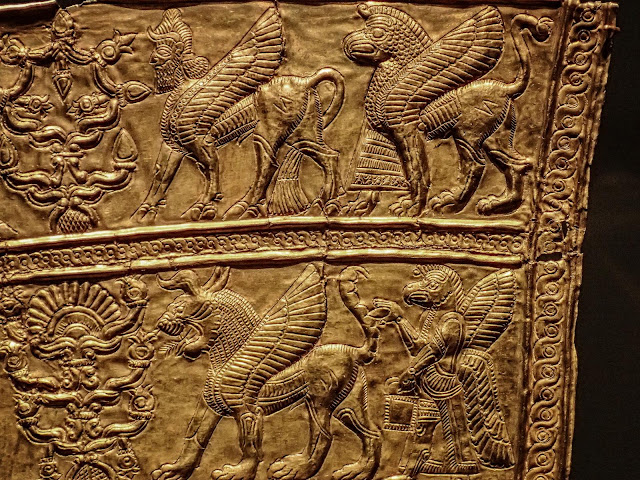Iron Age III gold cuirass fragments from Northwestern Iran, 8th-7th centuries BCE
In 2015, I had the opportunity to photograph artifacts in the Smithsonian's Sackler Gallery of Asian Art. In it, I found this spectacular fragment of a gold breastplate dating to the Iron Age III period. Other fragments of this breastplate are today in the Cincinnati Art Museum and in the Royal Ontario Museum in Toronto. Fragments from a second gold breastplate found in the burial mound near the village of Ziwiye are in the Metropolitan Museum of Art and in the National Museum in Teheran.
"This is a fragment from the lower part of a much larger pectoral, or breastplate, made of sheet metal and embellished with figures and ornament arranged in horizontal bands. A breastplate shielded the chest from arrows or other weapons. The decoration on this example consists of mythical guardian creatures, whose images were believed to provide magical protection for the wearer."
"A pectoral made of thin sheet gold, like this one, would have been attached to a sturdier material, probably leather. Given the fragility and cost of the material and its intricate decoration, the pectoral may have been fashioned specifically for ceremonial use or burial equipment." - Sackler Gallery, Smithsonian, Washington D.C.
"This plaque, perforated around the edge, was perhaps once attached to a garment of a wealthy lord or to the shroud of a prince. Its design is similar to contemporary art of Assyria, Urartu, and Scythian-style objects. The plaque was originally composed of seven registers decorated in repoussé and chasing; two were separated and are now in the collection of the Archaeological Museum, Tehran. The registers display the familiar composite creatures of the ancient Near East striding in groups of three toward a stylized sacred tree, the central motif. The human-headed, winged lion, seen in the first and third register, is a creature that also appears as a gate guardian on the doorjambs in the palace of Ashurnasirpal II at Nimrud. A sphinx struts along the second band, followed by winged lions and an ibex. The bodies of the fantastic creatures are composed of unusual combinations of animal and bird parts: in the uppermost register, the lions sport ostrich tails, while in the second, their tails are those of scorpions. The trees of life bear pomegranates, pine cones, and lotus flowers. Each scene is framed and separated by a delicate guilloche pattern." - Metropolitan Museum of Art, New York.
 |
| Closeup of the Iron Age III gold cuirass fragment from Northwestern Iran that I photographed at the Sackler Gallery of the Smithsonian in Washington DC. |
 |
| Iron Age III gold cuirass fragment from Northwestern Iran that I photographed at the Sackler Gallery of the Smithsonian in Washington DC. |
 |
| Another Iron Age III gold breastplate found in the same burial now in the Metropolitan Museum of Art in New York |



Comments
Post a Comment